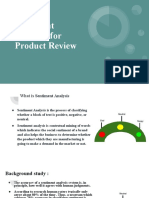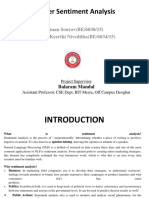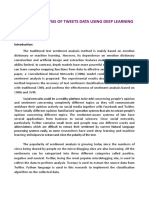0% found this document useful (0 votes)
32 views17 pagesNLP Project Report
This project report details the development of a sentiment analysis system for Apple product-related tweets using advanced natural language processing techniques. It aims to provide insights into consumer sentiment, covering over 22 Apple products and utilizing a user-friendly interface for real-time analysis. The system employs the DistilBERT model for accurate sentiment classification, though it is limited to English tweets and binary sentiment outputs.
Uploaded by
dehic55884Copyright
© © All Rights Reserved
We take content rights seriously. If you suspect this is your content, claim it here.
Available Formats
Download as PDF, TXT or read online on Scribd
0% found this document useful (0 votes)
32 views17 pagesNLP Project Report
This project report details the development of a sentiment analysis system for Apple product-related tweets using advanced natural language processing techniques. It aims to provide insights into consumer sentiment, covering over 22 Apple products and utilizing a user-friendly interface for real-time analysis. The system employs the DistilBERT model for accurate sentiment classification, though it is limited to English tweets and binary sentiment outputs.
Uploaded by
dehic55884Copyright
© © All Rights Reserved
We take content rights seriously. If you suspect this is your content, claim it here.
Available Formats
Download as PDF, TXT or read online on Scribd
/ 17





















































































